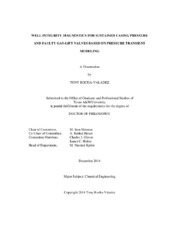| dc.description.abstract | A problem frequently present in the oil and gas industry is the difficulty of measuring well integrity parameters; particularly, for high-pressure high-temperature wells. For this reason, many relevant parameters, indicators of the integrity of the well, are not directly measured but rather qualitatively estimated by testing response variables, sometimes, unfortunately, without understanding the correlation between the key parameter and the response variable. This research presents methodologies to quantitatively evaluate well integrity in wells with sustained casing pressure (SCP) and gas-lifted wells with faulty gas-lift valves (GLV). The phenomenon occurring during these well integrity issues were modeled using the thermodynamic properties and transport phenomena occurring inside the wellbore. Well integrity denotes the ability to maintain intentional isolation between the formation and the well. The consequences of not detecting and managing well integrity issues can go from the activation of rupture discs to a release of oil/gas, fire and/or explosion during a blowout.
For the SCP problem, the developed analytic model has been validated against field data and compared to other numerical models showing similar performance. The SCP model allows for early time data to be used to accurately predict the leak’s severity by estimating a seepage factor, which is akin to permeability, to account for leakage occurring through the imperfect cement sheath. In comparison to current practices, the model shortens the testing time and reduces the risk from gas accumulation and pressure buildup, making it an inherently safer testing procedure.
The methodology developed to assess wellbore annular integrity, during gas-lift operations, has been compared to acoustic well sounding (AWS) data from different wells. The model divides the well into small elements and estimates average properties which are used to quantify the total amount of mass and hydrostatic pressure in the annulus at any given time. This methodology accurately tracks casinghead pressure and liquid level increase. When fluid intrusion occurs mostly through the gas-lift valve, the model allows estimating the damage coefficient of the faulty GLV. This coefficient serves as a quantitative parameter for GLV replacement; being independent of acoustic well sounding devices. This methodology has the advantages of easy and quick implementation, being accurate, not requiring any specialized equipment, and providing a quantitative damage parameter for the GLV. | en |


